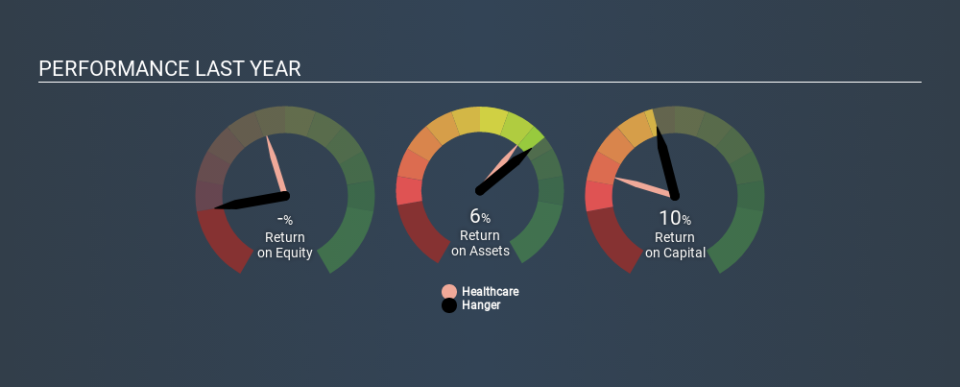Don’t Buy Hanger, Inc. (NYSE:HNGR) Until You Understand Its ROCE

Today we are going to look at Hanger, Inc. (NYSE:HNGR) to see whether it might be an attractive investment prospect. Specifically, we're going to calculate its Return On Capital Employed (ROCE), in the hopes of getting some insight into the business.
First, we'll go over how we calculate ROCE. Next, we'll compare it to others in its industry. And finally, we'll look at how its current liabilities are impacting its ROCE.
Understanding Return On Capital Employed (ROCE)
ROCE measures the amount of pre-tax profits a company can generate from the capital employed in its business. All else being equal, a better business will have a higher ROCE. Overall, it is a valuable metric that has its flaws. Renowned investment researcher Michael Mauboussin has suggested that a high ROCE can indicate that 'one dollar invested in the company generates value of more than one dollar'.
How Do You Calculate Return On Capital Employed?
Analysts use this formula to calculate return on capital employed:
Return on Capital Employed = Earnings Before Interest and Tax (EBIT) ÷ (Total Assets - Current Liabilities)
Or for Hanger:
0.10 = US$63m ÷ (US$801m - US$190m) (Based on the trailing twelve months to September 2019.)
Therefore, Hanger has an ROCE of 10%.
View our latest analysis for Hanger
Does Hanger Have A Good ROCE?
ROCE is commonly used for comparing the performance of similar businesses. It appears that Hanger's ROCE is fairly close to the Healthcare industry average of 11%. Separate from Hanger's performance relative to its industry, its ROCE in absolute terms looks satisfactory, and it may be worth researching in more depth.
In our analysis, Hanger's ROCE appears to be 10%, compared to 3 years ago, when its ROCE was 3.2%. This makes us think about whether the company has been reinvesting shrewdly. You can see in the image below how Hanger's ROCE compares to its industry. Click to see more on past growth.
When considering this metric, keep in mind that it is backwards looking, and not necessarily predictive. Companies in cyclical industries can be difficult to understand using ROCE, as returns typically look high during boom times, and low during busts. ROCE is only a point-in-time measure. What happens in the future is pretty important for investors, so we have prepared a free report on analyst forecasts for Hanger.
Hanger's Current Liabilities And Their Impact On Its ROCE
Liabilities, such as supplier bills and bank overdrafts, are referred to as current liabilities if they need to be paid within 12 months. The ROCE equation subtracts current liabilities from capital employed, so a company with a lot of current liabilities appears to have less capital employed, and a higher ROCE than otherwise. To counteract this, we check if a company has high current liabilities, relative to its total assets.
Hanger has total assets of US$801m and current liabilities of US$190m. Therefore its current liabilities are equivalent to approximately 24% of its total assets. Current liabilities are minimal, limiting the impact on ROCE.
What We Can Learn From Hanger's ROCE
With that in mind, Hanger's ROCE appears pretty good. Hanger looks strong on this analysis, but there are plenty of other companies that could be a good opportunity . Here is a free list of companies growing earnings rapidly.
If you are like me, then you will not want to miss this free list of growing companies that insiders are buying.
If you spot an error that warrants correction, please contact the editor at editorial-team@simplywallst.com. This article by Simply Wall St is general in nature. It does not constitute a recommendation to buy or sell any stock, and does not take account of your objectives, or your financial situation. Simply Wall St has no position in the stocks mentioned.
We aim to bring you long-term focused research analysis driven by fundamental data. Note that our analysis may not factor in the latest price-sensitive company announcements or qualitative material. Thank you for reading.

